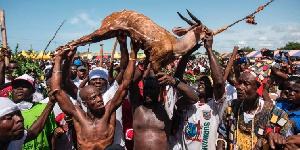Opinions of Saturday, 13 May 2023
Columnist: Cameron Duodu
From live leopard to live deer
I have spent the past week enthralled by TV pictures of the annual Winneba Deer-Catching Festival, that takes place in the Central Region town of Simpa, capital of the Efutu people, at the beginning of May each year.
Known in Fanti as “Aboakyer”, the festival is held in honour of the ancestral spirit of the Efutu people, whose power guided them safely from their original home in Western Sudan (in the neighbourhood of Timbuktu) from where they migrated to their present habitat hundreds of years ago.
Their migration was due to the exigencies of the time (which could include warfare and natural disasters (such as drought and the resultant famine it caused).
That the people still believe strongly in the salvation that Penkye Otu provided them on their long journey and their attempt to establish a new home in a strange environment, was evident from the zeal with which they danced through the streets of Winneba during the festival.
One was reminded by the deeds of the people on the streets of Winneba of the fact that the people, originally, needed to be extremely valiant in spirit because, in the past, the animal to be captured alive was –LEOPARD! You probably have heard of this animal, known locally as OSEBO or ETWIE! No one with any brains in his skull plays with that animal.
So, it was very impressive to watch the inherited lack of fear with which thousands of men, women and even adolescent children, voluntarily donned white or red clothing and trooped behind the Asafo “Companies” (Tuafo and Dentsifo) into the deep bush, in search of live animals. Okay, it was now a deer instead of a leopard. But what about snakes in the way? Thorns lying in wait for bare feet and ankles?
No fears: their objective was to capture a live deer and present it to Penkye Otu to tell the deity that they have not forgotten the protection that it gave their ancestors, which enabled Winneba to live, thrive and prosper to this day. And they would do that at any cost and prove to Penkye Otu – through their vigorous dancing and fierce war songs - that they were worthy of the continued protection of the deity, in the coming years. Because they were -- and ARE – a grateful people.
If you are able to go to www.Youtube.com on the internet, and search for “Winneba Aboakyer 2023”, I assure you that you will bless the day you bought a good computer or smart phone. Although some of the footage you will come across was shot by amateurs, you cannot help but join the people you see on the screen in enjoying the joyous atmosphere and the varying sights they encountered and how each was dealt with.
To me, the greatest spectacle of all was to see so many men and women, as well as boys and girls, FEARLESSLY enter a wide lagoon that separates the two sectors of the wilderness in which the deer have their habitat.
Wading through it may have had a terrifying effect on some people who live in the hinterlands of Ghana. But not these coasters. They waded through it without the slightest hesitation, and turned the whole experience into a game of you dare me, I dare you! Forwards and forwards they moved, till they entered the deep forest.
The sound of horns, whistles, gongongs and drums filled the air. Yells (some of them false alarms) were often heard before the deer got caught and was carried shoulder-high to the ancestral grounds and the durbar ground of Winneba.
I still wonder: So, in reality, were they not afraid of the lagoon? Suppose parts of it were deeper than was assumed. There were some dugout canoes on the surface. Didn't that indicate that some parts of the lagoon were quite deep?
Ho! If such fears entered their minds, they did not show it. It was forward, forward all the way.
The thought that occurred to me, as I watched it all, was this: in almost every town and village in Ghana, there is such a festival. The Asantes have their Akwasidae. .
The Akyems have their Ohum and Odwira and so on.
These ancestral festivals are a MEMENTO to the valour and wisdom exhibited by the people's ancestors that enabled their societies to survive until now.
White men's powerful guns could not wipe them out. When the men were deserted by courage – as during the Yaa Asantewaa War – the women took over.
They fought in their thousands. And they died in their thousands. But “if you killed a thousand, a thousand would come to replace them. Yet today, the rivers and water-bodies that sustained their lives are in danger of being destroyed. But unlike the people of old, we have nowhere else to go to!
Burkina Faso? Togo? Mali? Niger?
As-our people say, “If you haven't gone to someone else's dwelling place, it would sound attractive to you. But go there and see!”
We have nowhere else to go to. But how can we safeguard what we have? Without water, there will be NO people here. Only graves.
Watch this space, as we discuss in full frankness, how we can save Ghana from the extinction with which galamsey indisputably threatens her..
Entertainment










